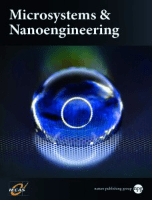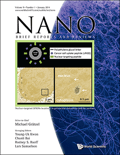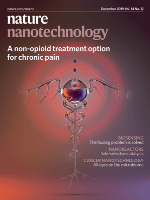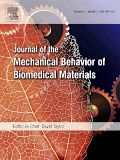
IEEE Open Journal of Nanotechnology
Scope & Guideline
Unlocking Innovations at the Nanoscale
Introduction
Aims and Scopes
- Nanomaterials and Nanostructures:
Research on the synthesis, characterization, and application of nanomaterials and nanostructures, including carbon nanotubes, graphene, and metal nanoparticles, focusing on their unique properties and potential applications in various fields. - Nanoelectronics and Nanoscale Devices:
Development and analysis of nanoelectronic devices, including transistors, sensors, and memristors, emphasizing their design, fabrication, and performance evaluation in next-generation electronic applications. - Nanotechnology in Biomedical Applications:
Exploration of nanotechnology's role in biomedical fields, including drug delivery systems, biosensors, and diagnostic tools, focusing on improving healthcare outcomes through innovative nanomaterials. - Nanoengineering and Manufacturing Techniques:
Advancement of manufacturing techniques for nanoscale materials and devices, including 3D printing, plasma technologies, and additive manufacturing, aimed at enhancing fabrication efficiency and material properties. - Computational Modeling and Simulation in Nanotechnology:
Utilization of computational methods and machine learning techniques to model and simulate nanomaterials and devices, providing insights into their behavior and guiding experimental design.
Trending and Emerging
- Integration of Machine Learning in Nanotechnology:
The application of machine learning techniques for modeling and optimizing nanostructures and devices is gaining traction, allowing for more efficient design processes and predictive analytics in nanotechnology research. - Flexible and Wearable Nanodevices:
There is a growing interest in the development of flexible and wearable nanodevices, particularly for applications in health monitoring and bio-sensing, driven by the demand for portable and user-friendly technologies. - Sustainable Nanotechnology:
Research focusing on the sustainability of nanomaterials and processes is on the rise, with an emphasis on eco-friendly production methods and the development of biodegradable nanomaterials for various applications. - Nanotechnology for Energy Applications:
Emerging themes include the use of nanotechnology for energy conversion and storage, such as nanomaterials for solar cells, batteries, and supercapacitors, reflecting the global push for renewable energy solutions. - Quantum Computing and Nanotechnology:
The intersection of quantum computing and nanotechnology is becoming increasingly relevant, with research exploring nanoscale components for quantum devices and circuits, highlighting the potential for revolutionary advancements in computation.
Declining or Waning
- Traditional Semiconductor Technologies:
Research on conventional semiconductor materials and devices, such as silicon-based technologies, is declining as the focus shifts towards novel materials and architectures that leverage the unique properties of nanomaterials. - Basic Theoretical Studies Without Experimental Validation:
Papers that present theoretical models without accompanying experimental evidence are becoming less frequent, reflecting a trend towards more applied research that demonstrates practical relevance and experimental support. - Single-Use or Less Sustainable Nanomaterials:
The emphasis on the development of single-use or less environmentally friendly nanomaterials is waning, as researchers increasingly prioritize sustainability and recyclability in their work.
Similar Journals

Microsystems & Nanoengineering
Advancing the Frontiers of Nanoscale InnovationMicrosystems & Nanoengineering, published by SpringerNature, stands at the forefront of advancing knowledge in the fields of atomic and molecular physics, condensed matter physics, electrical and electronic engineering, and materials science. With an impressive impact factor and categorized in Q1 across multiple prestigious fields in 2023, this journal not only provides a platform for high-quality research but also reflects the vitality of innovations within these disciplines. Since its transition to Open Access in 2015, it has significantly broadened accessibility for researchers, professionals, and students globally, facilitating the dissemination of groundbreaking findings. Addressed in the United Kingdom, with a focus on interdisciplinary collaboration, Microsystems & Nanoengineering aims to foster connections between theoretical advancements and practical applications, serving as a crucial resource for those engaged in cutting-edge nanoscale technologies and microsystems development. Immerse yourself in the latest studies and engage with the vibrant community that shapes the future of science and engineering.

Physical and Chemical Aspects of the Study of Clusters Nanostructures and Nanomaterials
Fostering Collaboration in Nanotechnology ResearchPhysical and Chemical Aspects of the Study of Clusters, Nanostructures, and Nanomaterials is an esteemed open-access journal published by TVER STATE UNIVERSITY, dedicated to advancing the scientific discourse surrounding the intricate interplay of physical and chemical properties in nanostructure materials. Launched in 2017, this journal provides a vital platform for researchers, professionals, and students to disseminate and access cutting-edge findings in the rapidly evolving fields of nanotechnology and materials science. With an ISSN of 2226-4442 and an E-ISSN of 2658-4360, it aims to bridge the gap between academic research and practical applications. By facilitating open access to high-quality research, the journal plays an essential role in promoting innovative solutions to contemporary challenges in engineering, materials development, and related industries. The journal's scope includes but is not limited to the synthesis, characterization, and functionalization of nanomaterials, ensuring comprehensive coverage of this multidisciplinary field.

NANO
Connecting Ideas in the World of NANONANO is an esteemed academic journal published by World Scientific Publishing Co. Pte Ltd, focusing on the frontier of nanoscience and nanotechnology. With ISSN 1793-2920 and E-ISSN 1793-7094, this journal has been a pivotal platform for disseminating innovative research from 2008 to 2024. Located in Singapore, NANO has established itself within the academic community, currently holding notable rankings in the Q3 Category for both Condensed Matter Physics and Materials Science, as well as a Q4 Category status in Nanoscience and Nanotechnology. Though it operates under a non-open access model, its contributions are invaluable for researchers, professionals, and students seeking to stay abreast of the latest advancements and interdisciplinary approaches within the nanoscale domain. By providing in-depth articles, reviews, and insights, NANO plays a significant role in advancing our understanding of materials at the nanoscale, thereby fostering innovation and collaboration across related fields.

Nature Nanotechnology
Elevating Knowledge in Nanotechnology and Beyond.Nature Nanotechnology, published by NATURE PORTFOLIO, stands at the forefront of scientific innovation, focusing on the rapidly evolving field of nanoscience and nanotechnology. With an impressive impact factor and ranking in the top Q1 quartiles across multiple disciplines—including Atomic and Molecular Physics, Bioengineering, and Materials Science—this journal is a pivotal resource for researchers and professionals dedicated to advancing knowledge and applications at the nanoscale. Its diverse scope encompasses cutting-edge research that bridges disciplines, addressing critical challenges in engineering, physics, and biomedical fields. Although the journal currently does not offer an open-access option, readers can access a wealth of information that is vital for anyone involved in pioneering research and development efforts. With its robust editorial standards and a commitment to publishing high-caliber, groundbreaking work, Nature Nanotechnology serves as an indispensable platform for the dissemination of transformative ideas that will shape the future of technology and science.

BME Frontiers
Exploring the Future of Biomedical EngineeringBME Frontiers, published by the American Association for the Advancement of Science, is an innovative open-access journal dedicated to the burgeoning field of Biomedical Engineering. Since its establishment in 2020, this journal has aimed to bridge the gap between cutting-edge research and practical application, promoting advancements in biomedical technologies, medical devices, and healthcare solutions. Boasting impressive rankings within Scopus—64th among 398 in Medicine (miscellaneous) and 81st among 303 in Biomedical Engineering—BME Frontiers stands out as a significant contributor to scholarly communication, offering rich insights for researchers, professionals, and students alike. With consistent publication projected through 2024, the journal serves as an essential platform for disseminating high-quality research that can drive innovation and inspire new approaches in the healthcare sector.

JOURNAL OF MATERIALS SCIENCE-MATERIALS IN MEDICINE
Advancing Biomedical Innovation through Materials ScienceJOURNAL OF MATERIALS SCIENCE-MATERIALS IN MEDICINE is a leading peer-reviewed journal published by Springer, dedicated to advancing the field of biomedical materials science. With an ISSN of 0957-4530 and E-ISSN 1573-4838, this Open Access journal has been committed to providing researchers and professionals with freely accessible, high-quality research since 2021. It features an extensive scope spanning bioengineering, biomaterials, biomedical engineering, and biophysics, reflecting its significant impact within these interdisciplinary domains. Recognized within the Q2 category of the 2023 rankings in multiple fields, the journal proudly positions itself as a crucial resource for innovative materials that contribute to advancements in medical applications. With impressive Scopus rankings, including 26th in Biophysics and 40th in Materials Science for Biomaterials, researchers, students, and industry professionals alike can rely on this publication for cutting-edge insights that drive the future of medical materials and technologies. Based in Dordrecht, Netherlands, the journal provides a vibrant platform for sharing groundbreaking discoveries and fostering collaborative research among a global audience.

Carbon Trends
Fostering Collaboration in Carbon ResearchCarbon Trends is a cutting-edge, openly accessible journal published by ELSEVIER, dedicated to advancing research and discussion in the domains of Chemistry, Materials Chemistry, and Materials Science. Established in 2020, this journal has quickly become a pivotal platform for scientists and researchers to share innovative findings related to carbon materials and their applications. With a solid impact factor and a ranking in the second quartile (Q2) across multiple subject categories, including a percentile standing in the top two-thirds of global publications, Carbon Trends plays an essential role in shaping the future of materials science. The journal’s open access model ensures that valuable research is accessible to a broad audience, facilitating collaboration and knowledge dissemination. Researchers, professionals, and students alike will benefit from the insights and trends published within its pages, guiding them in the rapidly evolving field of carbon sciences.

Nanomedicine Journal
Unlocking the Potential of Nanomedicine for All.Nanomedicine Journal, published by Mashhad University of Medical Sciences, serves as a vital platform for research and developments in the dynamic field of nanotechnology applied to medicine. With an ISSN of 2322-3049 and an E-ISSN of 2322-5904, this Open Access journal, operational since 2013, makes cutting-edge research freely accessible to encourage collaborative efforts in this rapidly evolving domain. The journal navigates various areas, including bioengineering, biomedical engineering, materials science, and pharmacology, holding prestigious rankings in categories relevant to these fields. The 2023 Scopus Rankings reveal its significant standing within the scientific community, particularly with a 76th percentile in general medicine. By bridging the gap between laboratory technologies and clinical applications, the Nanomedicine Journal aims to empower researchers, professionals, and students alike to contribute to the innovative landscape of nanomedicine. With a convergence period extending from 2019 to 2024 and an established reputation, this journal is essential for those pursuing advancements in therapeutic solutions and diagnostics through nanotechnology.

Journal of the Mechanical Behavior of Biomedical Materials
Innovating the Future of Healthcare Through Mechanical Behavior StudiesJournal of the Mechanical Behavior of Biomedical Materials is a leading academic publication dedicated to the intersection of mechanical engineering and biomedical innovation. Published by ELSEVIER in the Netherlands, this journal, which holds a solid presence within Q2 in Biomaterials and Biomedical Engineering, and Q1 in Mechanics of Materials as of 2023, features high-impact research with a measurable Scopus ranking that places it in the top tier of its fields. With an impressive percentile performance—82nd in Mechanics of Materials and 73rd in Biomedical Engineering—this journal serves as a vital resource for researchers, students, and professionals seeking to enrich their understanding of the mechanical behaviors of biomaterials and their applications. Spanning converged years from 2008 to 2024, it provides access to a wealth of pioneering research that advances the knowledge essential for the development of innovative biomedical applications. Engage with cutting-edge studies and broaden your expertise in the rapidly evolving realms of biomaterials and biomedical engineering through this authoritative publication.

Nanobiotechnology Reports
Exploring the synergy of nanotechnology and biology.Nanobiotechnology Reports, an impactful journal published by PLEIADES PUBLISHING INC, serves as a prominent platform for disseminating cutting-edge research at the intersection of nanotechnology and biotechnology. With its ISSN 2635-1676 and E-ISSN 2635-1684, this open-access journal is committed to providing researchers, professionals, and students with accessible knowledge and innovations that drive advancements in this rapidly evolving field. Operating out of the United States, Nanobiotechnology Reports has established itself in various engineering and science categories, including Bioengineering and Biomedical Engineering, currently holding a Q4 quartile ranking in 2023. Although it is in the early stages of its publication journey since its convergence in 2021, the journal aims to foster collaboration and knowledge-sharing within the scientific community, addressing the complexities of nanomaterials and their applications in biological systems. Researchers and practitioners in nanobiotechnology are encouraged to contribute to this expanding body of knowledge, facilitating the development of innovative solutions that impact various sectors, from healthcare to electronics.